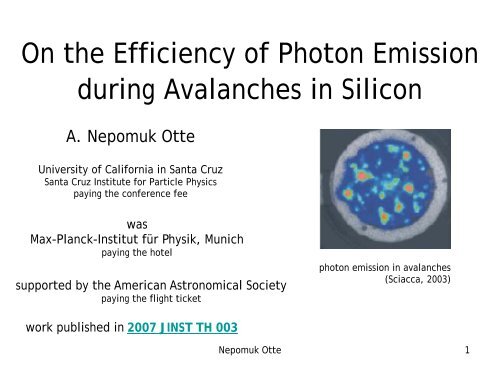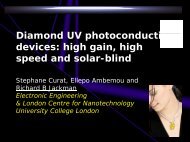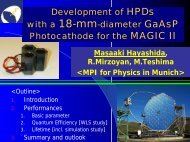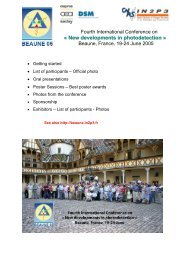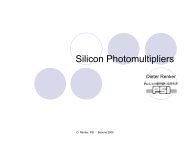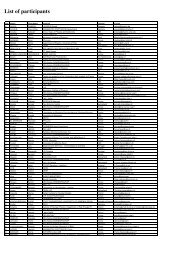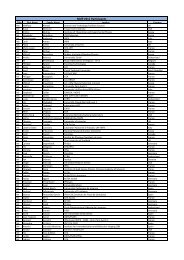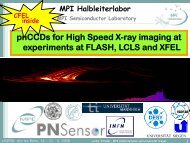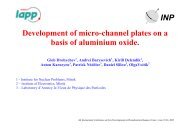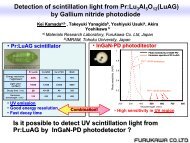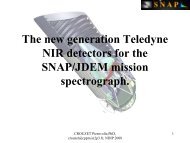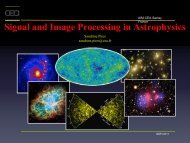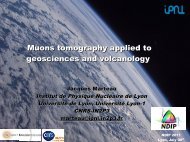Simulation of Optical Crosstalk in SiPM - NDIP 11
Simulation of Optical Crosstalk in SiPM - NDIP 11
Simulation of Optical Crosstalk in SiPM - NDIP 11
Create successful ePaper yourself
Turn your PDF publications into a flip-book with our unique Google optimized e-Paper software.
On the Efficiency <strong>of</strong> Photon Emission<br />
dur<strong>in</strong>g Avalanches <strong>in</strong> Silicon<br />
A. Nepomuk Otte<br />
University <strong>of</strong> California <strong>in</strong> Santa Cruz<br />
Santa Cruz Institute for Particle Physics<br />
pay<strong>in</strong>g the conference fee<br />
was<br />
Max-Planck-Institut für Physik, Munich<br />
pay<strong>in</strong>g the hotel<br />
supported by the American Astronomical Society<br />
pay<strong>in</strong>g the flight ticket<br />
work published <strong>in</strong><br />
2007 JINST TH 003<br />
photon emission <strong>in</strong> avalanches<br />
(Sciacca, 2003)<br />
Nepomuk Otte 1
Outl<strong>in</strong>e<br />
• SiSi the <strong>SiPM</strong> Simulator<br />
One example application <strong>of</strong> SiSi:<br />
characterize photon emission,<br />
which results <strong>in</strong> optical crosstalk<br />
Nepomuk Otte 2
SiSi*: The <strong>SiPM</strong> Simulator<br />
* Elisabeth ”Sis(s)i” von Wittelsbach the<br />
empress consort <strong>of</strong> Emperor Franz Joseph<br />
<strong>of</strong> Austria. She was born 1837 <strong>in</strong> Munich,<br />
Bavaria and murdered 1898 <strong>in</strong> Geneva,<br />
Switzerland<br />
a 3D Monte Carlo simulation package <strong>of</strong> <strong>SiPM</strong><br />
for the community<br />
to make it most affordable:<br />
It is free!<br />
send me an e-mail:<br />
nepomuk@scipp.ucsc.edu<br />
Nepomuk Otte 3
An application <strong>of</strong> SiSi:<br />
Why?<br />
Study Photon Emission <strong>in</strong><br />
The emission spectrum is uncerta<strong>in</strong>:<br />
and so is the underly<strong>in</strong>g physics<br />
• spectral measurements differ<br />
Avalanches<br />
• absolute <strong>in</strong>tensity/efficiency uncerta<strong>in</strong><br />
- direct measurement is difficult task<br />
- unit: photons emitted per avalanche carrier<br />
Nepomuk Otte 4
<strong>SiPM</strong>-Simulator: 3D-Geometry<br />
depleted and sensitive volume<br />
cross section <strong>of</strong> one cell 390µm<br />
42µm<br />
21µm<br />
geometrical description <strong>of</strong> a <strong>SiPM</strong>:<br />
• any number <strong>of</strong> cells / array layout<br />
• arbitrary<br />
- depleted / undepleted volumes<br />
- avalanche region<br />
- <strong>in</strong>sensitive regions<br />
- …<br />
depleted but non-sensitive volume<br />
2.5µm<br />
non-depleted bulk<br />
avalanche region<br />
Nepomuk Otte 5
<strong>SiPM</strong>-Simulator: Treatment <strong>of</strong> Photons<br />
photon emission <strong>in</strong> avalanches:<br />
• emission spectrum (free parameter)<br />
use Planck-spectrum<br />
• <strong>in</strong>tensity/efficiency (free parameter)<br />
• isotropic emission<br />
ray-trac<strong>in</strong>g <strong>of</strong> photons <strong>in</strong> the <strong>SiPM</strong>:<br />
• surface reflections<br />
• wavelength dependent absorption<br />
creation <strong>of</strong> charge carrier<br />
• diffusion (<strong>in</strong> non-depleted volume)<br />
• drift (<strong>in</strong> depleted volume)<br />
possible<br />
breakdown <strong>of</strong><br />
another cell<br />
Nepomuk Otte 6
Two Simulated Events<br />
one cell triggered at random (blue)<br />
<strong>SiPM</strong> with 24x24 cells<br />
simulated device<br />
correlated fir<strong>in</strong>g <strong>of</strong> other cells optical crosstalk<br />
MEPhI / Pulsar from 2003<br />
the excess noise <strong>of</strong> <strong>SiPM</strong><br />
Nepomuk Otte 7
How to learn about Photon Emission?<br />
1. take an<br />
exist<strong>in</strong>g device<br />
+<br />
have a good<br />
relationship to<br />
the producer<br />
3. Repeat<br />
measurement<br />
<strong>in</strong> the<br />
simulation<br />
MEPhI / Pulsar<br />
4. change free parameters<br />
temperature and <strong>in</strong>tensity<br />
until<br />
measured crosstalk<br />
distributions match<br />
(m<strong>in</strong>imiz<strong>in</strong>g χ²)<br />
2. trigger on dark<br />
counts and measure<br />
how <strong>of</strong>ten N cells are<br />
fired simultaneous<br />
(crosstalk distribution)<br />
same data but<br />
different b<strong>in</strong>n<strong>in</strong>g<br />
Nepomuk Otte 8
F<strong>in</strong>d Parameters that match<br />
<strong>Crosstalk</strong> Distribution<br />
T = 4500 K<br />
Total <strong>in</strong>tensity = 1.45x10 -4<br />
photons per avalanche<br />
carrier<br />
not a unique solution for Temperature and Intensity<br />
Residuals<br />
dark counts, which are<br />
not simulated<br />
Nepomuk Otte 9
<strong>Optical</strong> <strong>Crosstalk</strong> Photons:<br />
Photons that cause a breakdown <strong>of</strong> another <strong>SiPM</strong> cell<br />
energy distribution <strong>of</strong> optical crosstalk photons<br />
2000K and 4500K<br />
emission spectra<br />
after adjust<strong>in</strong>g the <strong>in</strong>tensity,<br />
different spectral shapes result <strong>in</strong><br />
the same energy distribution <strong>of</strong><br />
optical crosstalk photons<br />
Precise knowledge <strong>of</strong><br />
spectral shape not<br />
required<br />
reduces the free parameters to one:<br />
the <strong>in</strong>tensity <strong>of</strong> photon emission between<br />
~1.1 and 1.4 eV<br />
Nepomuk Otte 10
note the<br />
log-scale<br />
~10µm – 1mm absorption length<br />
= characteristic lengths <strong>of</strong> the <strong>SiPM</strong><br />
strong energy dependent absorption <strong>of</strong> photons <strong>in</strong> silicon<br />
Nepomuk Otte <strong>11</strong>
Photon Emission dur<strong>in</strong>g Avalanches<br />
<strong>in</strong> Silicon<br />
<strong>in</strong>tegrat<strong>in</strong>g the emission spectrum 1.1eV …1.4 eV:<br />
photons with energies<br />
between 1.1eV and 1.4eV are emitted with<br />
an efficiency <strong>of</strong><br />
3*10 -5 photons per avalanche carrier<br />
result does not depend on the shape <strong>of</strong> the emission spectrum<br />
the result does depend on:<br />
uncerta<strong>in</strong>ties <strong>in</strong> the geometry <strong>of</strong> the measured <strong>SiPM</strong><br />
homogeneity <strong>of</strong> avalanche region and <strong>SiPM</strong><br />
<strong>in</strong>troduces a systematic uncerta<strong>in</strong>ty by a factor <strong>of</strong> 2<br />
Nepomuk Otte 12
Conclusions<br />
• SiSi a free <strong>SiPM</strong> Simulator<br />
– write me: nepomuk@scipp.ucsc.edu<br />
• crosstalk measurements can be used to characterize photon<br />
emission dur<strong>in</strong>g avalanches<br />
• only photons with<strong>in</strong> a narrow energy <strong>in</strong>terval (1.1eV-1.4eV) cause<br />
optical crosstalk; reason: strong energy dependence <strong>of</strong> absorption<br />
lengths<br />
• measured <strong>in</strong>tensity <strong>of</strong> photons between 1.1eV-1.40eV : ~3•10 -5<br />
photons / avalanche electron-hole pair; estimated uncerta<strong>in</strong>ty: 2<br />
Nepomuk Otte 13
χ² -distribution <strong>of</strong> a scan <strong>in</strong>:<br />
• temperature <strong>of</strong> photon spectrum<br />
• <strong>in</strong>tensity <strong>of</strong> photon spectrum<br />
x<br />
no unique solution <strong>of</strong> model parameters but<br />
log scale<br />
Nepomuk Otte 14
4500K<br />
Electron Lifetimes<br />
2000K<br />
Intensity <strong>of</strong> the photons is reduced by ~30%<br />
if lifetime <strong>of</strong> the electrons <strong>in</strong> the non-depleted volume is non-zero<br />
Nepomuk Otte 15


